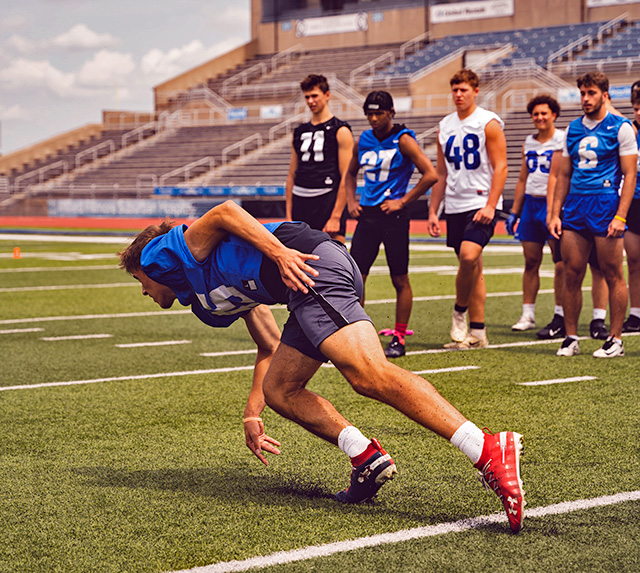As part of the NFL draft camp testing event - officially the National Invitational Camp (NIC) - the invited-only prospective players have interviews with teams and a comprehensive physical, medical and psychological testing program.
 football combine fitness testing
football combine fitness testingSince 1979, some sort of scouting testing was performed, leading to the first official combine in 1982 where players and team scouts got together to see prospects put through their paces (see more on the history of the combine).
Below is an outline of the range of tests currently conducted at the combine. For the top scores in many of these tests, see the NFL Combine Results. See also the poll about Which NFL Combine event do you think is the most important?
There are other combines too - see details of a quarterback specific combine, the NFL Veteran Combine and the Regional Combines.
Physical Testing
physical measurements |
Each prospect has measurements of height, weight, arm length, and hand length. Also running backs and linemen’s body fat percentage are measured using the 'bod pod'. |
This is a test of speed and power. From a three-point stance, a player runs 40 yards as fast as he can. Split times are recorded at 10 and 20 yards to measure acceleration. The 10-yard time is especially important for offensive and defensive linesmen because they usually don't run further than that during a play. |
|
The bench press test is a test of upper body strength. Each player must bench press 225 lbs. as many times as they can. Quarterbacks and wide receivers are exempt from the test. The bench press is the most important for offensive and defensive linemen. - it is planned to remove the bench press test from the player assessments |
|
A test of explosion and power. The player jumps off both feet straight up as high as he can. The vertical jump is most important for receivers and defensive backs. |
|
Similar to the vertical jump, this is a test of lower body strength, explosion, and power. The broad jump measures how far you can jump, not how high. From a standing position, the player jumps forward off two feet as far as he can. The broad jump is the most important for running backs, linemen, and linebackers. |
|
Also called the 5-10-5 Shuttle, this is a test of agility including speed, explosion and changing of directions. Technique is also important. Each player will be timed how fast they can go 5 yards laterally, then 10 back in the opposite direction, and finishing 5 yards back to the start line. |
|
This is an agility test where the players runs around three cones placed in the shape of an "L". There are 5 yards between each cone. |
|
This is an anaerobic test, a ladder shuttle of progressing distances. From a starting line, a player runs 5 yards and back, then 10 yards and back, then 15 yards and back, touching the line each time. |
Skill Testing
- position-specific drills: Each prospect must go through football drills designed for their specific position. The results of the drills are somewhat overlooked since the fitness test numbers is what everyone seems to care about. One position specific drill is the one-on-one pass coverage.
Psychology
- Since the 1970s, the Wonderlic test, an intelligence type test, has been given to combine attendees. In 2013, an additional new 60-minutes long test was added to the testing program. This new and expanded player assessment tool was designed to offer a much more robust and comprehensive assessment of a player’s non-physical capabilities, aptitudes, and strengths. The test measures a wide range of competencies, including learning styles, motivation, decision-making skills, responding to pressure or unexpected stimuli, and core intellect. The results of the new test, like the Wonderlic test (which will still be administered), remain confidential. - it is planned to remove the Wonderlic test from the player assessments
Medical
- injury evaluation: Each prospect will go through X-rays and physicals to determine their current injuries and their injury histories. Injured prospects coming into the combine will get closely looked at.
- drug screen: each prospect will take a urine test to check for substances that are not allowed in the NFL. They will be looking for illegal drugs such as marijuana and cocaine, and performance-enhancing drugs. More about drug testing.
- functional movement screening: a functional movement screen for performance testing was added since about 2015. In 2018 a new performance test was conducted (with the help of a group called Sparta Science) to help give NFL clubs an extra layer of information on a prospect's physical capabilities, a balance and jump test. Sparta Science tracks athletes making six jumps in 90 seconds with its force plate technology and proprietary software to predict what injuries they are in danger of suffering, what workouts they need to stay healthy and what sport or position best suits their athletic ability.
- cybex test: The Cybex Test is not the most important test prospects must go through. Although, injured and previously injured prospect’s results in the Cybex Test will get serious looks from coaches. The Cybex Test tests the flexibility and joint movement of each prospect. Each prospect will be hooked to a machine which will determine their results.
- Urine test: Each prospective player must pass a urine drug test, designed to identify any substances deemed illegal by the NFL including marijuana, cocaine and performance-enhancing drugs.
Related Pages
- Football Fitness Testing.
- Top NFL Combine Results for each test.
- About a NFL Quarterback Combine.
- About the NFL Veteran Combine and Regional Combines
- Football SPARQ Fitness Rating System.
- Poll about the fitness components for football.
- Comparing fitness testing for Sports Combines
- NBA, AFL and NHL combine tests.
- All about Fitness Testing.


 Current Events
Current Events